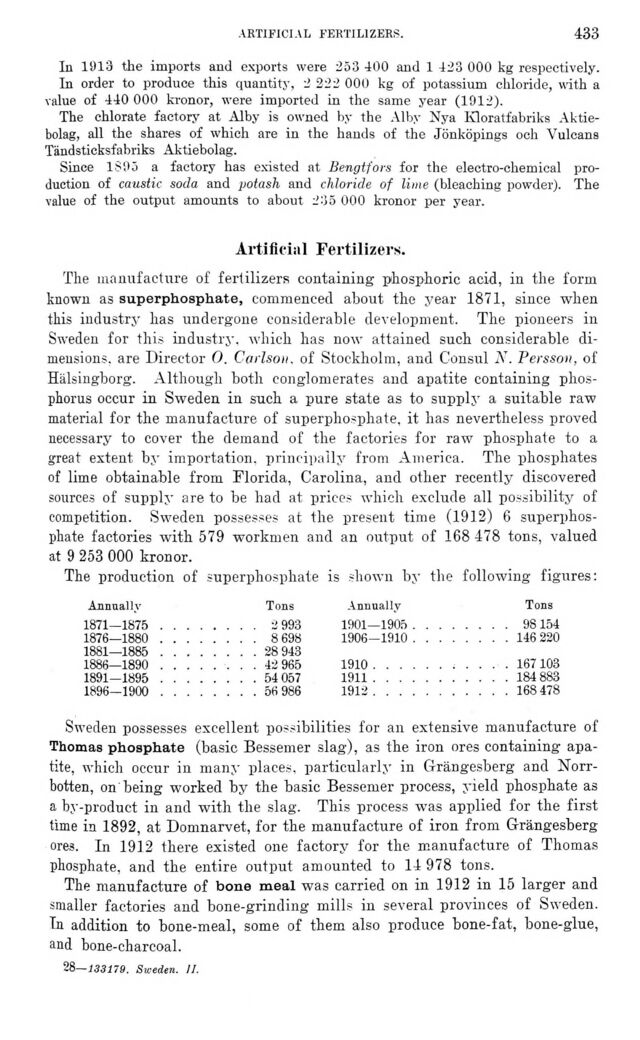
Full resolution (JPEG) - On this page / på denna sida - VII. Manufacturing Industries. Introd. by [G. Sundbärg] K. Åmark - 9. Chemical Industries. By Alf. Larson

<< prev. page << föreg. sida << >> nästa sida >> next page >>
Below is the raw OCR text
from the above scanned image.
Do you see an error? Proofread the page now!
Här nedan syns maskintolkade texten från faksimilbilden ovan.
Ser du något fel? Korrekturläs sidan nu!
This page has never been proofread. / Denna sida har aldrig korrekturlästs.
artificial fertilizers.
433
In 1913 the imports and exports were 253 400 and 1 423 000 kg respectively.
In order to produce this quantity, 2 222 000 kg of potassium chloride, with a
value of 440 000 kronor, were imported in the same year (1912).
The chlorate factory at Alby is owned by the Alby Nya Kloratfabriks
Aktiebolag, all the shares of which are in the hands of the Jönköpings och Vulcans
Tändsticksfabriks Aktiebolag.
Since 1S95 a factory has existed at Bengtfors for the electro-chemical
production of caustic soda and potash and chloride of Ume (bleaching powder). The
value of the output amounts to about 235 000 kronor per year.
Artificial Fertilizers.
The manufacture of fertilizers containing phosphoric acid, in the form
known as superphosphate, commenced about the year 1871, since when
this industry has undergone considerable development. The pioneers in
Sweden for this industry, which has now attained such considerable
dimensions, are Director O. Carlson, of Stockholm, and Consul N. Persson, of
Hälsingborg, Although both conglomerates and apatite containing
phosphorus occur in Sweden in such a pure state as to supply a suitable raw
material for the manufacture of superphosphate, it has nevertheless proved
necessary to cover the demand of the factories for raw phosphate to a
great extent by importation, principally from America. The phosphates
of lime obtainable from Florida, Carolina, and other recently discovered
sources of supply are to be had at prices which exclude all possibility of
competition. Sweden possesses at the present time (1912) 6
superphosphate factories with 579 workmen and an output of 168 478 tons, valued
at 9 253 000 kronor.
The production of superphosphate is shown by the following figures:
Annually Tons
1871—1875 ........ 2 993
1876—1880 ........ 8 698
1881—1885 ........ 28 943
1886—1890 ........ 42 965
1891-1895 ........ 54 057
1896-1900 ........ 56 986
Sweden possesses excellent possibilities for an extensive manufacture of
Thomas phosphate (basic Bessemer slag), as the iron ores containing
apatite, which occur in many places, particularly in Grängesberg and
Norrbotten, on being worked by the basic Bessemer process, yield phosphate as
a by-product in and with the slag. This process was applied for the first
time in 1892, at Domnarvet, for the manufacture of iron from Grängesberg
ores. In 1912 there existed one factory for the manufacture of Thomas
phosphate, and the entire output amounted to 14 978 tons.
The manufacture of bone meal was carried on in 1912 in 15 larger and
smaller factories and bone-grinding mills in several provinces of Sweden.
Tn addition to bone-meal, some of them also produce bone-fat, bone-glue,
and bone-charcoal.
28—133179. Sweden. //.
1901—1905 ................98 154
1906-1910 ................146 220
191 0...........167103
1911 ......................184 883
1912 ......................168 478
<< prev. page << föreg. sida << >> nästa sida >> next page >>